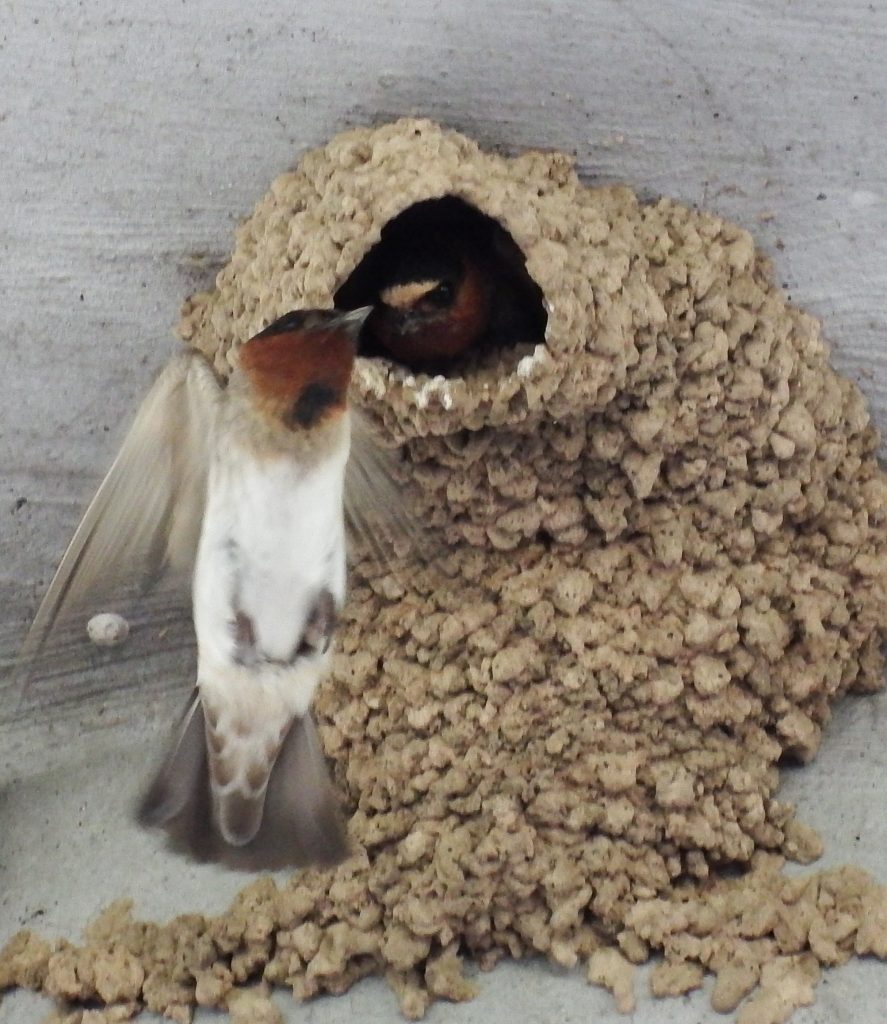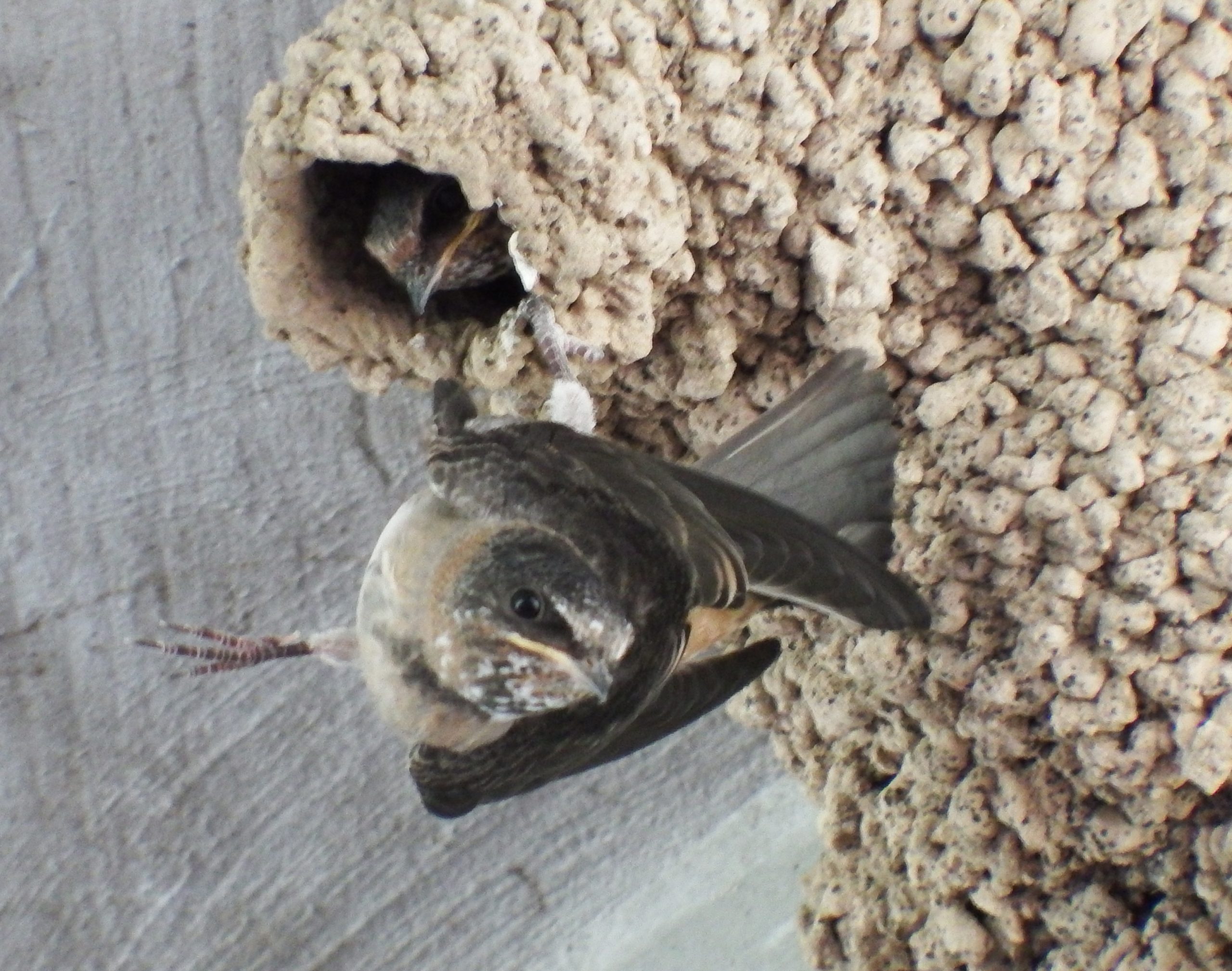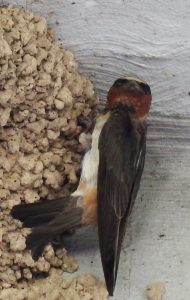Drama and Mystery in the Cliff Swallow Colony
 Usually, when I’m on my Buffalo Bayou Park rambles, I will encounter something interesting, take bunches of photos and then use my nature library, knowledgeable fellow Master Naturalists and the Internet to figure out what the heck I saw and then write it up in an authoritative tone as though I had come armed with all the information.
Usually, when I’m on my Buffalo Bayou Park rambles, I will encounter something interesting, take bunches of photos and then use my nature library, knowledgeable fellow Master Naturalists and the Internet to figure out what the heck I saw and then write it up in an authoritative tone as though I had come armed with all the information.
This post will be a bit different because I’m not entirely certain what was going on. It is a mystery, so I will present it as such with all the clues and what I think they might mean.
Cliff Swallows Gone Wild
The Cliff Swallows were crazy on Friday. They are busy birds. They catch insects on the wing and are agile and graceful flyers, but what was going on Friday looked the Rice marching band — apparently pointless energetic motion that eventually resolves into something sensible. But I was having trouble with that last part.
This was the action at a single nest. Birds leave, birds arrive, a bird tries to enter and is rejected and if you look carefully, at the end, you can see that there are two birds still in the nest even after one leaves.
Hypothesis 1: Late arrivals looking to lay eggs
As faithful readers of this blog know, we have a Cliff Swallow colony under the bat bridge. Each year, our colony returns from South America to rehabilitate their old mud nests and raise a new brood of birds. This year, they returned to find their nests destroyed by Harvey flood waters. The returning Swallows rebuilt their colony.
When I visit the Cliff Swallows, they seem busy and purposeful — rebuilding nests, repeat flights to catch insects and popping into the nest to feed the hatchlings. But now, birds were swarming all over the nesting area. The flights looked purposeless and frenetic. I kept my eyes on a single bird and watched as this bird flew from nest to nest, looking for a place to land, rejected each time by birds already perched or occupying the nest. Why? Cliff Swallows will lay eggs in each other’s nests. In fact, female birds will carry eggs from one nest to another. Were birds looking to sneak in an extra brood on someone’s else’s nest?
I saw a bird land on a half-built nest, and wondered if maybe a second wave of birds had arrived from their migration desperate for a place to lay. I watched for the mate to arrive with a beak full of mud to help build the rest of the nest. But no one came. Or rather, everyone came. Lots of birds randomly landing, again to no apparent purpose.
Hypothesis 2: Baby birds are idiots
Baby birds are the natural world’s hors-d’oeuvres. Tiny, tender and defenseless. Their only hope is flight. So the first big developmental effort by a bird is to grow the feathers and muscles that take it to the air. This results in baby birds who are able to fly before they are able to care for themselves in any meaningful way.
Perhaps these were juvenile birds. I did see a bird gape open its mouth as another bird approached. That’s how baby birds entice their parents to give them food. But it seemed as though this gaping bird went unfed. The action takes place around the 14-second mark.
Perhaps these strange and pointless flights were very young birds being idiots?
…Not complete idiots
I had been watching and photographing the chaos of the Cliff Swallows for over 45 minutes when a single Jay cried out and everyone took off. Other Jays took up the cry and eventually I saw them chasing a small hawk. With my chances for further observation diminished, I returned home to see what the camera had captured.
Who you calling a baby?
This is a breeding colony and it makes sense that by now, it should be full of baby birds. But 90% of the birds I was seeing and photographing had what looked to me like adult plumage. This photo shows two juvenile Cliff Swallows. It would be hard to confuse them with an adult Cliff Swallow.
The bird in the photo on the right, however, looks a whole lot more like an adult, except it still has a bit of mottling on its throat. How do I identify a juvenile? Hawks, Night Herons, Gulls and many other birds retain their juvenile plumage for a year or more. Most songbirds look almost like adults as soon as they can fly. I had a few birds in obvious juvenile plumage and a whole lot more who looked a heck of a lot like adults. So, does a tiny bit of mottling mean it’s a juvenile? Comparing the birds I photographed recently with the many photos I took of the birds returning and rebuilding their nests (had to be adults), I still couldn’t figure it out.
A solution hiding in plain sight
My plan was to end this post with the question, not the answer. But when I was preparing the video clips, I had an idea. That clip showing the gaping bird (the second clip in this post), what if I slowed it down and got a good look at what really happened. Guess what, magic!
You can see that the parent flies by, turns his/her head and feeds the juvenile. Then the juvenile Cliff Swallow swallows!
Cliff Swallows live on the wing. Parents feed juveniles in the wing as well, so it would have to happen quickly. And it sure did! I don’t have proof, but I bet that photo at the top of the post is a parent passing food to their youngster, backwards and on the wing!
The Creche
Cliff Swallow juveniles form what’s called a creche. The youngsters band together as a group in a safe place away from the nesting area. I know this only because I read about it, and I cannot find much more information than that, but I now understand why they would do it. The nesting area is complete chaos with that many birds of slightly different ages (depending on when eggs were laid). It is a massive draw for predators. When I was visiting on Friday, there were five Night Herons hanging around for a chance meal and two hawks came calling. I imagine in a few days, the youngsters will be safely away from the colony in their creche. If I find it, expect yet a third post on Cliff Swallows.



